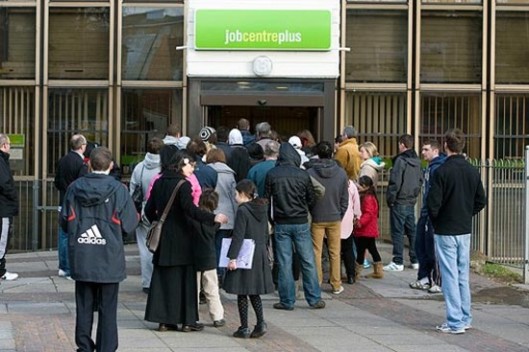
Please note: As ever, this is a layman’s view of the figures. If anyone can help add colour and detail to what follows – and correct it if necessary – please do.
Let’s hope we all live long enough to look back and laugh at the euphoric reporting of the Coalition government’s slanted employment figures.
“UK unemployment fell by 57,000 to 2.51 million in the three months to May,” the BBC reported, quoting today’s release from the Office for National Statistics.
What a shame that the figure is meaningless as it bears no relation to the number of people who are out of work and not paid the minimum wage (or above), which would be a better yardstick. That figure is anything up to 11.71 million, using estimated figures from the ONS report.
This includes not only the number officially counted as unemployed, but those counted as ‘economically inactive’ and those on government-sponsored schemes such as Workfare or the Work Programme – who work, but are paid only in government benefit money and therefore, as the taxpayer is picking up the tab, should be counted with the unemployed.
People who are ‘economically inactive’ include people who are not seeking work, such as those looking after the family or home, those who don’t want or need a job, and those who have retired early – which is why this group is not included in ONS unemployment figures – but also includes those seeking work but officially unavailable for it, such as students in their final year, people who cannot work for health-related reasons, and ‘discouraged workers’ who believe there are no jobs available.
The trouble is, the statistics do not show the numbers of people in each of these sub-categories, meaning we cannot – for example – get meaningful figures for those unable to work due to poor health. Also, we have no mortality figures – we don’t know how many people have been removed from the workforce because they have died.
This means that the deeply worrying figure of 103,000 fewer people who are economically inactive due to long-term illness is meaningless. Have they died? Have they found work (this is highly unlikely – see Vox’s article on the failure of Work Programme provider companies in this respect)? Have they all miraculously got better and moved into a different category? We simply don’t know, and these figures are extremely frustrating in this respect alone.
The figures suggest that 29.71 million people are in employment, including more than a million who have multiple jobs. They may or may not be among the 8.038 million part-time workers – the statistical estimate does not go into that detail. This adds up to 71.4 per cent of everyone aged from 16 to retirement age (around 41 million of us); excluding the economically-inactive, this goes up to 92 per cent. The part-timers are 27 per cent of the total between 16-64, and 19 per cent of the economically-active.
That means that the 2.51 million people officially designated unemployed constitute eight per cent of the economically-active workforce (or six per cent of the total).
So we’re a long, long way from full employment – and that’s without even going into whether these people are being paid enough!
Not only that, but we should subtract 160,000 people from the ‘employed’ figure. This is the number on government-sponsored work schemes, being paid benefit money by the taxpayer in lieu of the proper wage they deserve. So 29.55 million people have jobs and 2.67 million don’t.
This makes little difference to the percentages, nor can we say that anyone has been lying – they have merely been quoting the figures as required of them.
Let’s fill in some of the gaps in the ‘economically inactive’ category: Of the 9.04 million recorded here (up by 87,000) we have 1.95 million students aged 16-24 not looking for work, and 330,000 older students in the same situation, plus 1.38 million early retirements – an increase of 8,000.
Long-term sickness accounts for 2.04 million – an increase of 26,000 on the previous quarter but (as previously mentioned) down 103,000 on a year earlier.
The retired population totals 10.597 million (up 92,000).
We can blow a few myths out of the water:
David Cameron’s claim that a million private sector jobs have been created is absolute piffle. The ONS acknowledges that 196,000 public sector employees were reclassified into the private sector by an Act of Parliament in 2011, to do with educational bodies. Removing this from the statistics, the number of public sector jobs fell by 112,000 in the last year, while the number of private sector jobs did increase – but by only 544,000 – a country mile away from Cameron’s boast.
Claims that the private sector now employs more than 23 million people are also inaccurate – if not so widely. Take away the number of people on government-sponsored work schemes from the 24.059 million private employees claimed by the ONS and you’re left with 23.9 million. Public sector employment stands at 5.697 million.
Those are the facts – as far as we can take them. Without further information about people who don’t want or need a job, and about those who are looking after the home or family, it is impossible to say how many of the ‘economically inactive’ might be looking for work.
And without further details about those in long-term sickness, we can only fear for the condition of the 103,000 who have fallen off the ledger.